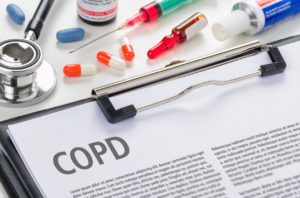Chronic obstructive pulmonary disease (COPD) is an incurable but treatable condition that affects over 16 million Americans who have been diagnosed with the disease. Many others suffer from it unknowingly.
The acronym COPD is an umbrella term that covers any disease affecting airway obstructions, especially emphysema and chronic bronchitis. Let’s take a look at the causes, symptoms, and ultimate treatments of the various disorders included in COPD.
Causes and Symptoms of COPD
The primary cause for COPD in developed nations like the United States is cigarette smoking. In underdeveloped nations, it tends to occur when people are overexposed to burning fuel for cooking or to heating elements in poorly ventilated homes and buildings.
The main types of COPD in the U.S. are chronic bronchitis and emphysema:
Chronic Bronchitis
This condition occurs when there is inflammation of the bronchial tubes, causing the bronchial tubes to narrow and produce excessive mucus. The narrowing and extra mucus together block airflow to and from the lungs, and sufferers develop a chronic cough while trying to breathe.
Emphysema
This is a condition whereby the smallest air passageways in the lungs are destroyed, causing shortness of breath. Emphysema is a result of exposure to damaging substances from smoking, irritating gases, or other particulate matter that gets trapped in the lungs and causes damage. Smaller airways can collapse when exhaling, further impairing breathing.
Treatment for COPD
Any of the COPD health conditions are manageable. They do require certain changes in lifestyle. The best way to manage your COPD symptoms is to stop smoking and to avoid secondhand smoke whenever possible.
Medical treatments for COPD include a bronchodilator, which comes in an inhaler. This medication can help relax the muscles of the airway, relieving coughing and making it easier to breathe.
Inhalant forms of steroids can also help with the symptoms of COPD, although they do have certain unpleasant side effects. You and your family medicine provider can discuss whether the benefits outweigh the effects of COPD.
Oxygen therapy can also help considerably. There are modern ways of carrying around a portable oxygen tank that make it less obvious than before. Portable oxygen has indeed proven to extend the lifespan and improve the quality of life of a person with COPD.
Diagnosis of COPD
To get a diagnosis, your family medicine provider will first review your family history. Up to 30% of people with COPD were never smokers, so the family medicine provider will be checking for a genetic predisposition to lung issues. The family medicine provider will also discuss any potential exposure to lung irritants like cigarettes, or exposure to harmful fumes in the workplace.
They will also perform a series of diagnostic tests, such as the following:
- Spirometry is a machine with a tube that measures how much air you can inhale and how quickly (and how much) air you can exhale.
- A chest X-ray can show the presence of emphysema and rule out other potential problems.
- A CT scan can detect emphysema and determine whether surgery could be beneficial, while it also screens for lung cancer.
- An arterial-blood gas analysis will test how well the lungs bring oxygen to the blood and filter out carbon dioxide.
Family Medicine Provider in Palm Beach County
COPD is a serious illness that requires management and medical supervision in order to continue enjoying life. If you are in the Wellington or Royal Palm Beach area, contact our team to schedule an appointment at Advanced Medical Clinic.
Call us today at (561) 434-1935 or request an appointment online now, and let us help you get back to better breathing!


